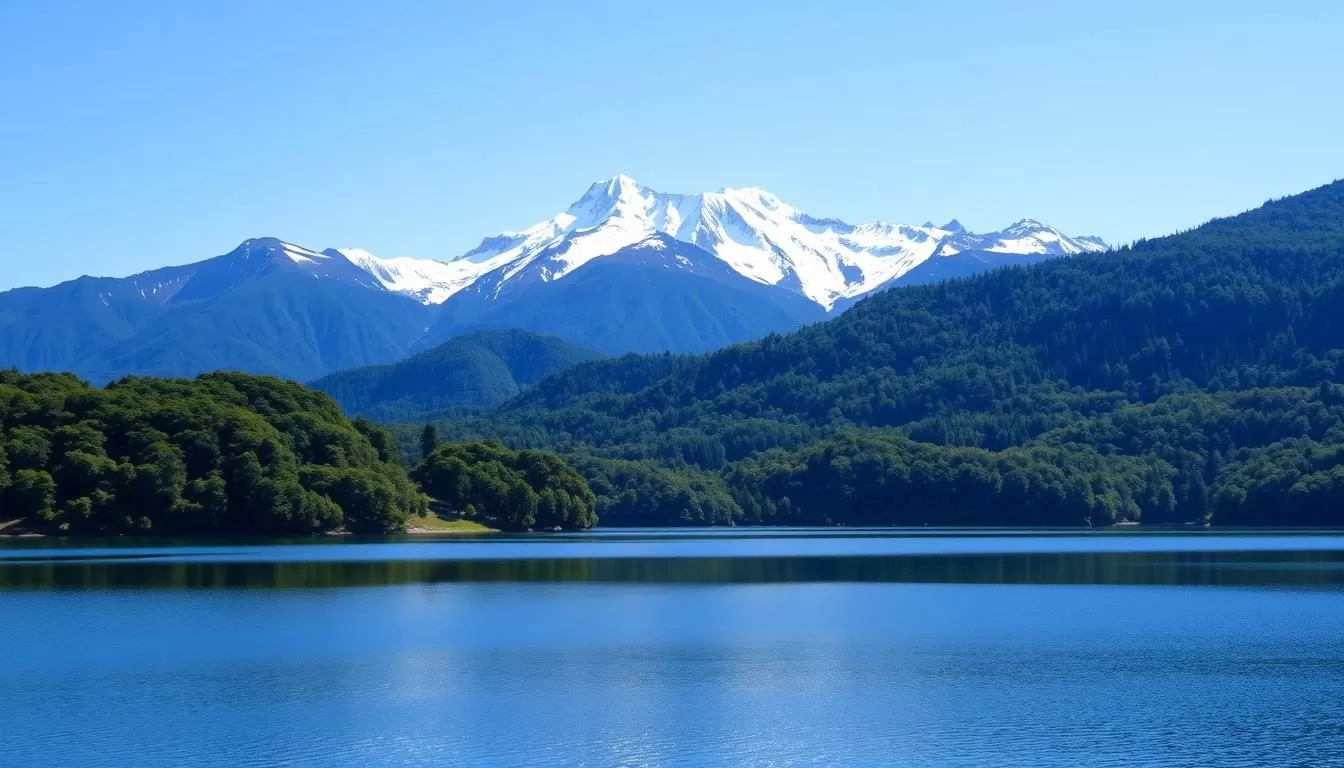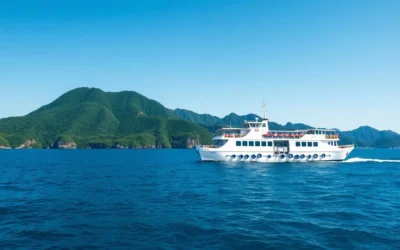✓ Accommodations✓ Flights✓ Rental Cars
Are you looking for an authentic Japanese experience beyond the typical tourist hotspots? The Chūgoku Region in western Honshu offers a perfect blend of history, culture, and natural beauty, making it an ideal destination for travelers.
This region comprises five distinct prefectures, each with its own unique attractions and experiences that showcase different aspects of Japanese heritage and landscapes. From historical sites to breathtaking natural scenery, the Chūgoku Region presents diverse views and experiences.
With its less-crowded atmosphere, the region serves as a great alternative to popular destinations, allowing for a more intimate exploration of Japanese culture and traditions. Whether you’re interested in history, nature, or local cuisine, the Chūgoku Region has something to offer.
Discovering Japan’s Hidden Gem: The Chūgoku Region
Tucked away in the western part of Honshu, Japan’s largest island, lies the Chūgoku Region, a treasure trove of natural beauty and cultural heritage. As you explore this enchanting area, you’ll discover a unique blend of traditional Japan and untouched landscapes.
Where is the Chūgoku Region?
The Chūgoku Region is situated in the westernmost part of Honshu, strategically positioned between the Sea of Japan to the north and the Seto Inland Sea to the south. This geographic location has historically made the region an important cultural and economic bridge between mainland Asia and the rest of Japan.
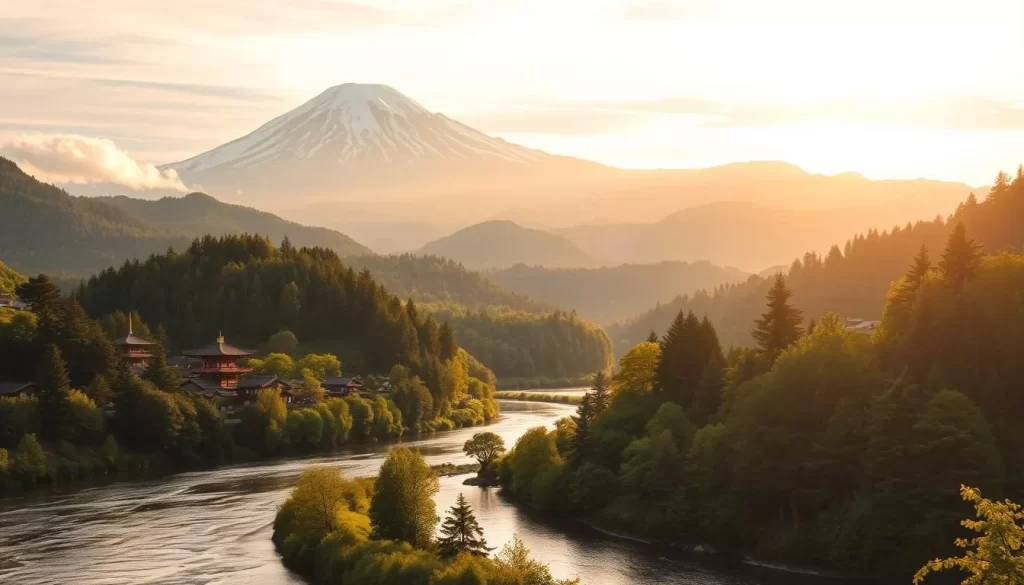
The Five Prefectures of Chūgoku
The region encompasses five distinct prefectures: Hiroshima, Yamaguchi, Shimane, Tottori, and Okayama. Each offers unique landscapes and cultural experiences that represent different aspects of Japanese heritage. You can explore the serene landscapes of Daisen-Oki National Park, visit the iconic floating torii gate at Itsukushima Shrine on Miyajima Island, or enjoy the charming mix of history and traditional architecture in towns like Okayama and Kurashiki.
The Chūgoku Region maintains much of its traditional character, providing visitors with authentic experiences of Japanese life, architecture, and customs. With its diverse geography, including coastal plains, inland mountains, and unique natural formations, the region supports different lifestyles and industries, making it a perfect destination for travelers seeking off-the-beaten-path experiences.
Best Time to Visit the Chūgoku Region
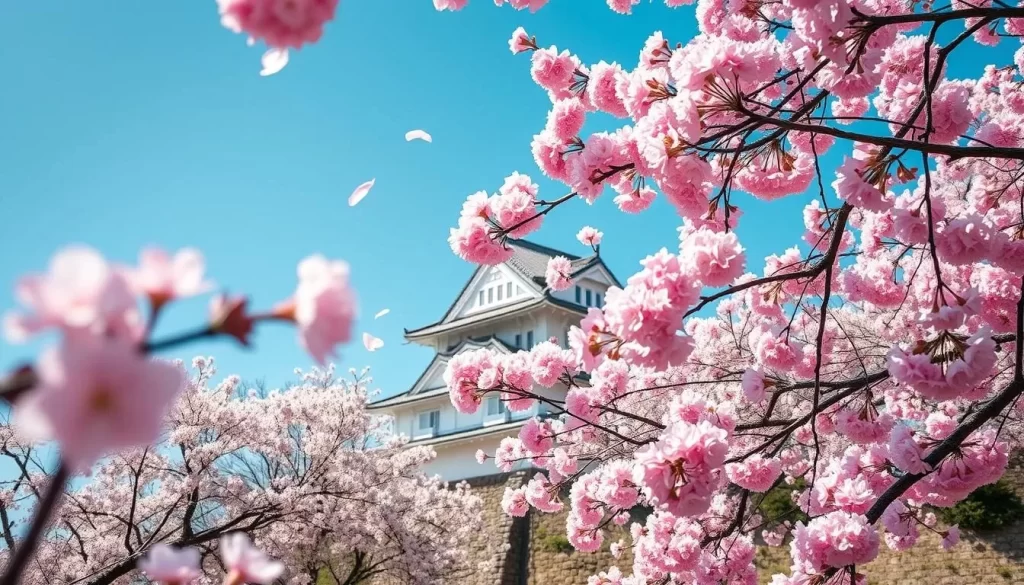
To make the most of your trip to the Chūgoku Region, it’s essential to know the best time to visit. The region experiences four distinct seasons, each offering unique experiences and attractions.
Seasonal Highlights
The Chūgoku Region is a year-round destination. In the spring (March to May), enjoy the spectacular cherry blossom season, transforming gardens and castle grounds into pink wonderlands. For instance, take an early-April picnic under the pink petals of Matsue Castle or go hiking and boating in the rugged Sadankyo Gorge.
In the fall (September to November), the region features comfortable temperatures and stunning autumn foliage, creating dramatic landscapes, particularly in mountainous areas and Japanese gardens.
Weather Considerations
When planning your visit, consider the rainy season (typically June) and typhoon season (August to September). For the optimal balance of pleasant weather and cultural experiences, plan your visit during the shoulder seasons of late spring or early fall.
Hiroshima: History and Hope
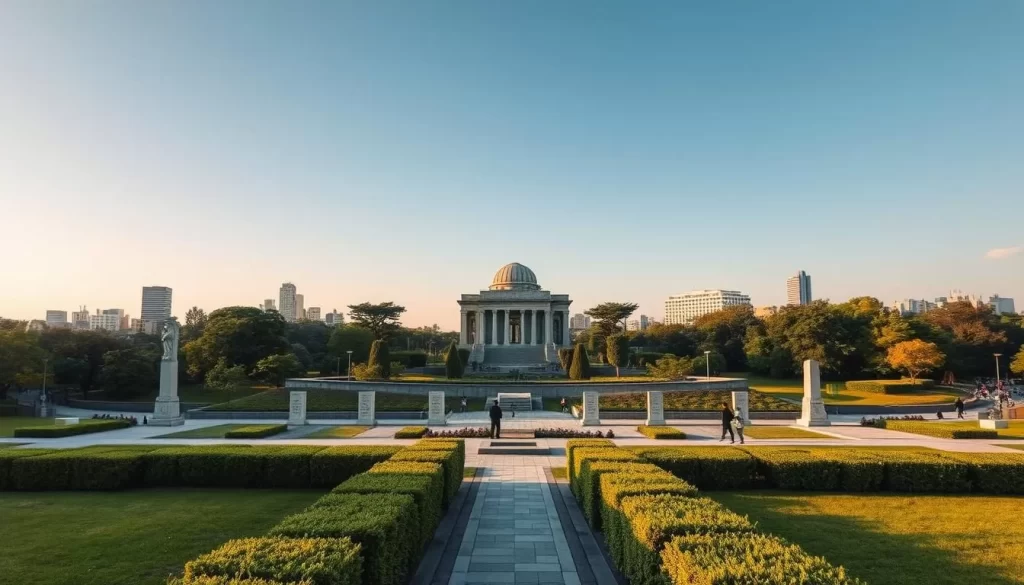
Hiroshima stands as a testament to the human spirit’s capacity for hope and recovery. You can explore the city’s poignant history and its transformation into a vibrant, forward-looking city.
Hiroshima Peace Memorial Park and Museum
The Hiroshima Peace Memorial Park and Museum form the emotional and educational center of the city. You can visit the preserved A-Bomb Dome, a stark reminder of the atomic bombing, while surrounding monuments and exhibits promote a message of world peace.
Hiroshima Castle
Beyond its wartime history, Hiroshima showcases its rich cultural heritage through Hiroshima Castle, a beautiful reconstruction that houses exhibits on the city’s pre-war history and samurai culture. You can explore the castle and learn about its significance in the city’s past.
Local Cuisine: Hiroshima-Style Okonomiyaki
The local food culture is headlined by Hiroshima-style okonomiyaki, a distinctive layered savory pancake that differs from its Osaka counterpart. You can try this unique dish, which incorporates yakisoba noodles and a unique preparation method, making it a point of culinary pride for the city.
By visiting Hiroshima, you’ll experience a city that balances its role as a place of historical significance with its identity as a dynamic, contemporary Japanese city with shopping districts, parks, and a passionate baseball culture.
Miyajima Island: Home of the Floating Torii
![]()
Miyajima Island, with its iconic floating torii gate, is a must-visit destination in Japan, attracting travelers from around the world. Located in the Seto Inland Sea, this sacred island is known for its breathtaking scenery and historical significance.
Itsukushima Shrine and the Iconic Torii Gate
The island’s most iconic feature is the “floating” torii gate of Itsukushima Shrine, a vermillion structure that appears to float on water during high tide, creating one of the most photographed and recognizable images of Japan in the world. This shrine is the only one of its kind located in the sea, making it a unique spiritual site.
Mount Misen Hiking Trails
Beyond the famous shrine, Miyajima offers excellent hiking opportunities on Mount Misen, where a network of trails leads to the 535-meter summit, rewarding hikers with panoramic views of the Seto Inland Sea and surrounding islands.
Miyajima’s Friendly Deer
The island is home to hundreds of friendly wild deer that roam freely throughout the streets and shrine grounds, believed to be messengers of the gods in Shinto religion, adding to the magical atmosphere of Miyajima Island.
Tottori Prefecture: Sand Dunes and Manga Culture
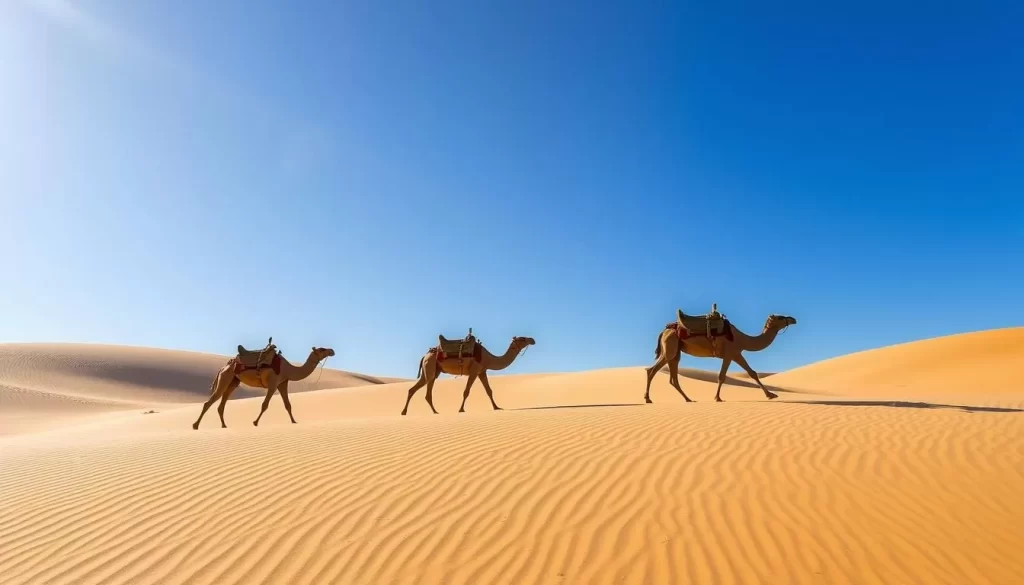
If you’re looking for a different Japan, Tottori Prefecture is the place to visit, with its stunning sand dunes and vibrant manga scene. This unique part of the Chūgoku Region offers experiences that are distinctly different from typical Japanese landscapes.
Exploring Japan’s Largest Sand Dunes
The Tottori Sand Dunes, or Tottori Sakyu, are a natural wonder, stretching 10 km in length and up to 2 km wide. You can enjoy various activities here, such as riding camels, sandboarding, and paragliding, making it a fascinating place to explore.
Manga Museums and Pop Culture
Tottori is also a hub for manga enthusiasts, being the hometown of renowned manga artists like Gosho Aoyama and Shigeru Mizuki. You can visit dedicated museums and see public art installations that celebrate their work, experiencing the local culture in a unique way.
Mount Daisen: Hiking and Skiing
For those who enjoy outdoor activities, Mount Daisen offers excellent hiking trails in the summer and skiing opportunities in the winter. It’s a great way to enjoy the natural beauty of Tottori Prefecture.
Shimane Prefecture: Ancient Shrines and Natural Beauty
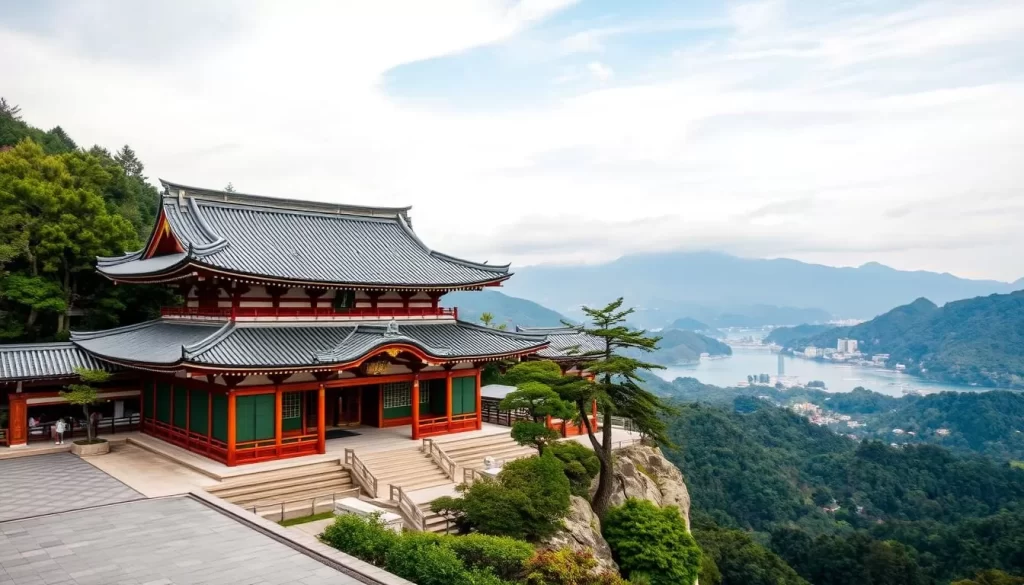
As you explore Shimane Prefecture, you’ll uncover a rich tapestry of history, spirituality, and breathtaking landscapes. This region is home to some of Japan’s most revered shrines and temples, showcasing the country’s deep spiritual heritage.
Izumo Taisha: The Gathering Place of Gods
Izumo Taisha stands as one of Japan’s oldest and most important Shinto shrines, famous for its massive shimenawa (sacred rope). It’s believed that all of Japan’s eight million deities gather here annually in the tenth lunar month, making it a significant pilgrimage site.
Iwami Ginzan Silver Mine: A UNESCO World Heritage Site
The Iwami Ginzan Silver Mine, a UNESCO World Heritage Site, represents a different aspect of Shimane’s historical significance. This mine was active for 400 years and played a crucial role in Japan’s silver production, influencing global trade during the 16th-19th centuries.
Matsue Castle and Lake Shinji
Matsue, known as the “City of Water,” offers a more urban experience centered around its feudal-era castle and Lake Shinji, where sunset views are considered among the most beautiful in the country.
Shimane Prefecture’s blend of profound spiritual sites, historical industrial heritage, and natural beauty provides visitors with a deeper understanding of traditional Japanese values and the historical development that shaped the nation’s identity on the world stage.
Okayama Prefecture: Gardens and Historic Districts
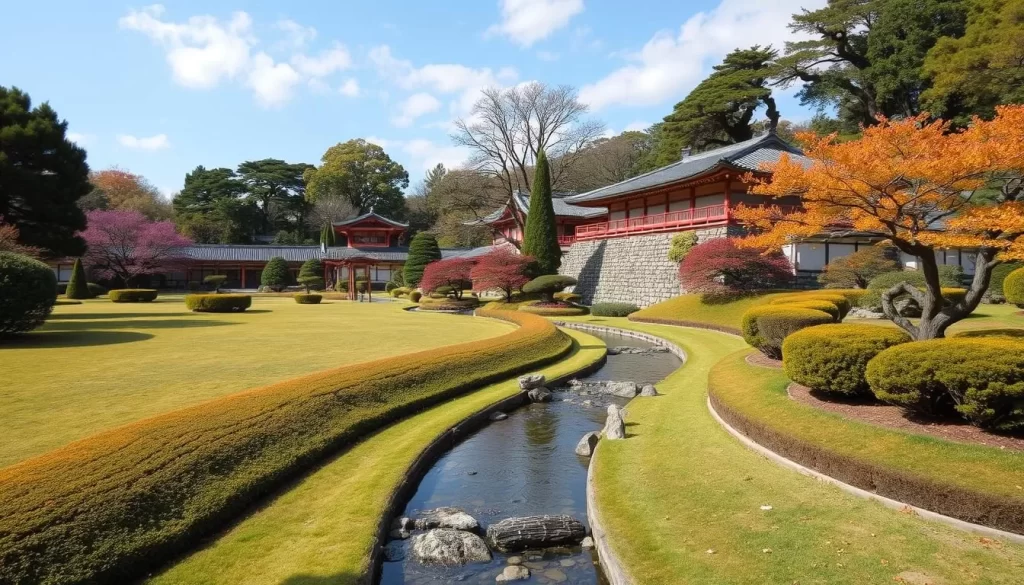
Okayama Prefecture is a treasure trove of Japan’s rich cultural heritage, boasting stunning gardens and historic districts that are sure to captivate any visitor. The prefecture is home to Korakuen Garden, one of Japan’s most beautiful and historic gardens.
Korakuen: One of Japan’s Three Great Gardens
Korakuen Garden is renowned for its stunning landscapes that change with the seasons. Its thoughtful design incorporates expansive lawns, meandering streams, and carefully placed teahouses, creating a serene atmosphere that invites visitors to stroll and appreciate its beauty.
Kurashiki Bikan Historical Quarter
The Kurashiki Bikan Historical Quarter is a charming town with a Venice-esque atmosphere, featuring canals lined with white-walled storehouses that have been repurposed into museums, boutiques, and cafes. Visitors can enjoy a traditional boat ride along the canals, taking in the historic scenery.
Okayama Castle
Okayama Castle, also known as “Crow Castle” due to its distinctive black exterior, stands proudly beside Korakuen Garden. The castle houses exhibits on samurai culture and local history, providing insight into the region’s rich cultural heritage.
Okayama Prefecture’s blend of meticulously preserved gardens, historic architecture, and cultural institutions makes it a compelling destination for those interested in traditional Japanese culture. Whether exploring the serene gardens, visiting the historic castle, or wandering through the charming city districts, visitors are sure to be enchanted by Okayama’s unique charm.
Yamaguchi Prefecture: Bridges and Traditional Japan
As you explore Yamaguchi Prefecture, you’ll discover a region rich in cultural heritage and breathtaking landscapes. Located at the westernmost tip of Honshu and facing the Seto Inland Sea, this prefecture has historically served as a gateway between Japan and the Asian mainland.
Kintaikyo Bridge: An Architectural Marvel
The Kintaikyo Bridge in Iwakuni is an engineering masterpiece, featuring five sequential wooden arches constructed without nails since the 17th century. It’s a great spot, just a short cablecar ride from the castle, surrounded by lovely restaurants.
Shimonoseki: The Fugu Capital
Shimonoseki is renowned as Japan’s fugu capital, where specially licensed chefs prepare this delicacy. The city’s strategic location at the Kanmon Strait offers unique experiences, including underwater tunnels connecting Honshu and Kyushu.
Akiyoshido Cave and Akiyoshidai Plateau
The Akiyoshidai Plateau features Japan’s largest karst landscape, and beneath it lies the Akiyoshido Cave, the country’s longest limestone cave system. These natural wonders offer breathtaking views and unique geological formations.
Yamaguchi Prefecture retains many traditional towns and historical sites, reflecting its importance during the late Edo period. It’s an excellent destination for history enthusiasts and those looking to experience traditional Japan in various areas.
Culinary Delights of the Chūgoku Region
As you explore the Chūgoku Region, you’ll discover a rich culinary landscape that’s heavily influenced by its geography. The region’s diverse prefectures offer a wide range of local specialties that are sure to tantalize your taste buds.
Fresh Catch
The Chūgoku Region is renowned for its seafood, with coastal prefectures specializing in fresh catches from both the Seto Inland Sea and the Sea of Japan. Hiroshima is Japan’s biggest producer of oysters, which are served raw, steamed, and grilled year-round.
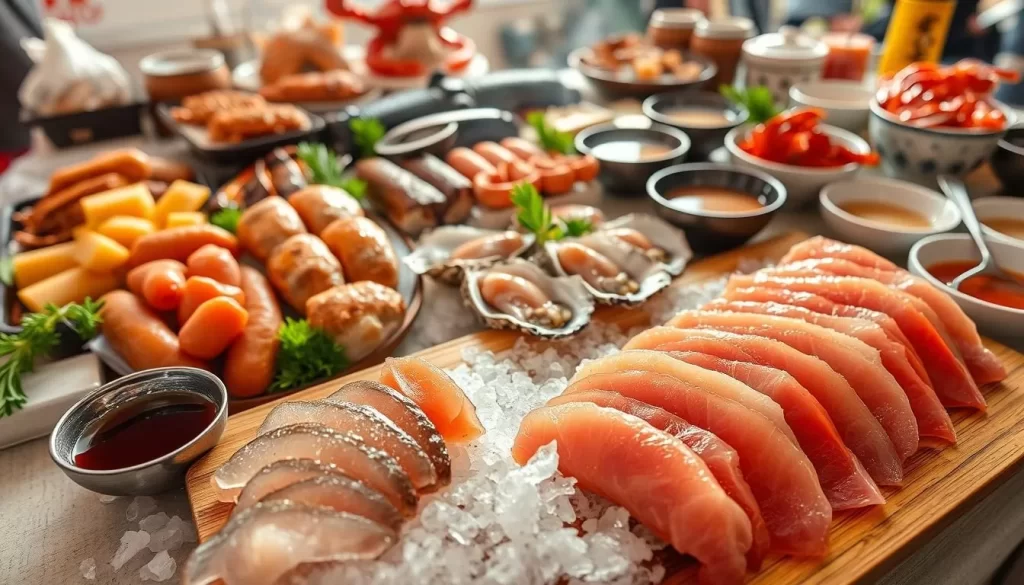
Regional Specialties
Some must-try local dishes include Hiroshima-style okonomiyaki, which differs from other versions by layering ingredients and incorporating yakisoba noodles. You can also sample Tottori and Shimane’s exceptional crab, particularly the prized Matsuba crab available during winter months.
| Prefecture | Specialty | Best Time |
|---|---|---|
| Hiroshima | Oysters | Year-round |
| Tottori, Shimane | Matsuba Crab | Winter |
| Yamaguchi | Fugu (Pufferfish) | Various seasons |
The region also produces excellent sake, with each prefecture having its own breweries that utilize local water sources and rice varieties. The best time to enjoy many of these specialties is during their respective seasons.
Planning Your Trip to the Chūgoku Region
To make the most of your visit to Chugoku, it’s essential to plan strategically, taking into account the region’s expansive geography and diverse attractions. The Chūgoku Region spans five prefectures, each with its unique charm and attractions, making transportation planning crucial.
You can access major cities like Hiroshima and Okayama using the Shinkansen (bullet train), which serve as excellent bases for exploring their respective prefectures. For travelers with limited time, focusing on one or two prefectures is advisable. Consider purchasing a JR West Railpass for extensive travel within the region. Additionally, be prepared for potential language barriers in rural areas by having a translation app and pre-downloaded maps. The best time to visit is during spring (March-May) and autumn (September-November) for mild temperatures and seasonal attractions.
The above is subject to change.
Check back often to TRAVEL.COM for the latest travel tips and deals.
